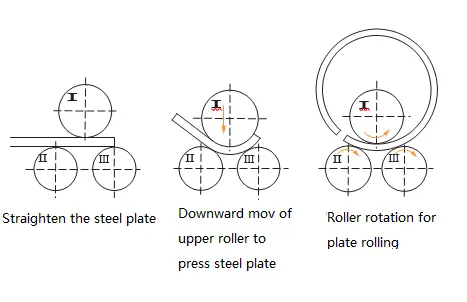Ever wondered how the metal around you is getting its shape? Be it an automobile part, a ship, or a large metal container. It's not magic, but a machine breathing life into metal and turning it into breathtaking art.
Plate rolling is an incredibly essential part of any metal industry. The task of these rolling machines is simple: shaping metal plates into cones, cylinders, and curved shapes.
The definition looks simple, but the plate bending/rolling machines deliver sophisticated, cutting-edge, unique products. Different types of plate rolling/bending machines are available in the market. This blog will have a detailed view of a 3-roll plate rolling/ bending machine's working principle and rolling process.
What is a Plate Bending/Rolling Machine?
A Plate Rolling machine, also known as a roller machine, is a metal rolling equipment. Its main purpose is to shape metals into conical, cylindrical, or curved shapes. Industries worldwide require different machines according to their needs.
Plate rolling is a complex process but crucial for expanding the bending options available to your customers. Moreover, it depends on the precision levels and skill set of operators.
What Are the Types of Roll Plate Bending Machines?
There are three types of plate rolling/bending machines that individual industries need:
2-roll Plate Bending/Rolling machine
3-roll Plate Bending/Rolling machine
4-roll Plate Bending/Rolling machine
As mentioned above, each machine has its individual use, but here we will have a look at the 3-roll Plate Bending/Rolling machine.
What is the Working Principle of a 3-Roll Plate Rolling/Bending Machine?
Before understanding the working, let's have a brief look at a 3-Roll Plate Rolling/Bending Machine.
Industries of all sizes, from shipping to metal fabrication, need 3-roll plate bending/rolling machines. The process/task of the machine remains the same: bending metal sheets into the desired shape.
A 3-roll bending machine has three rolls: two side rolls that move back and forth, while the upper roll stays fixed but rotates. You can interchange this upper roll to fit shells of varying sizes.

Images 1, 2, and 3 show how a 3-roll plate bending machine uses rollers A, B, and C to shape metal plates. This is a pre-pinching/pre-bending process in plate bending.
The manufacturer can control the amount and speed of the rollers to achieve the desired shape. As you can see, the plate smoothly and uniformly bends/rolls using the three rollers. The engineer can also bend or roll the desired location to achieve the required shape during the pre-bending process.
Let’s have a look at the mechanism in detailed steps.
Step 1: Placing the Plate
The first step for rolling a plate is placing the plate between the upper (I) and lower rollers (II and III). This process bends the plate into an arc or closed circle. As the metal sheet passes through the three cutting points created by the rollers, the plate will mold into the desired shape.
(Have a look at Diagram 1 of the working principle of a 3-roll rotating/ bending machine.)
Step 2: Plastic Bending Deformation
After the insertion of the metal plate, the top roller applies downward pressure on the plate. As a result, the plate undergoes a plastic bending deformation process due to compression.
Plastic bending deformation of metals occurs when an object's shape and size change due to applied force. Deformation happens when the shape of a material or object changes due to pressure. Plastic deformation occurs when the applied force is enough to cause a permanent deformation.
Step 3: Rotation & Friction
Due to the friction between the rollers and the plates, the lower rollers begin rotating, causing the plate to move back and forth along its longitudinal direction.
The plate moves back and forth as the lower roller alternatively does a forward and reverse rotation. At the same time, the upper roller continuously exerts vertical pressure or downward pressure on the plate.
The stress will exceed the yield limit during this process. Now the plastic deformation will occur. You can see the plate going through a plastic bending deformation. This entire process lets the plate take the required shape.

Key Factors of a 3-Roll Plate Bending/ Rolling Machine
To bend the plate to a radius no longer than the upper roller, you can modify the relative position of the upper and lower rollers.
A motor and a reducer power the lower roller (II and III), making them rotate in a similar momentum and the same or opposite direction.
To vary the curvature of the desired plates, you can adjust the position of the upper rollers.
You can change the position of the upper rollers to vary the curvature of the desired plates. Moreover, you can readjust the upper roller if you do not receive the desired curvature after a single rolling process. Then, you can redo the process until you achieve the desired shape.
There is one disadvantage of this machine. When you look at the above diagram, you can notice that the three rolls of the 3-roll bending/rotating machine form an isosceles triangle.
During the process, this triangle-forming shape forces the two ends of the machine to leave a straight part. The straight part of the machine is half the distance between the centers of the two lower rollers. This is the part where the rollers cannot roll.
Despite this one disadvantage, there are several benefits and features of a 3-roll plate bending machine. The main benefits of this plate rolling machine are structure, ease of operation, and low cost.
Wrapping Up!
3-roll plate bending machines have played an important role in history and continue to do so. You can rely on our plate-bending machines across various industries, including shipping, oil tanks, metal structures, tubes, and pipes. Be it 2-roll bending, 3-roll bending, or 4-roll bending machines.
We hope this blog helped you understand the working principle of our 3-roll bending machine. Feel free to contact us for all your plate-bending machinery needs. Our team at Himalaya Machinery would love to help you.


Comments